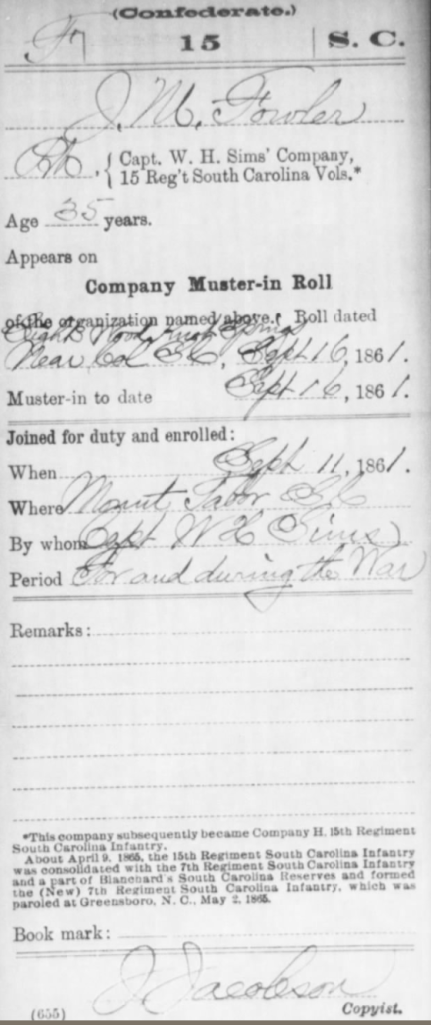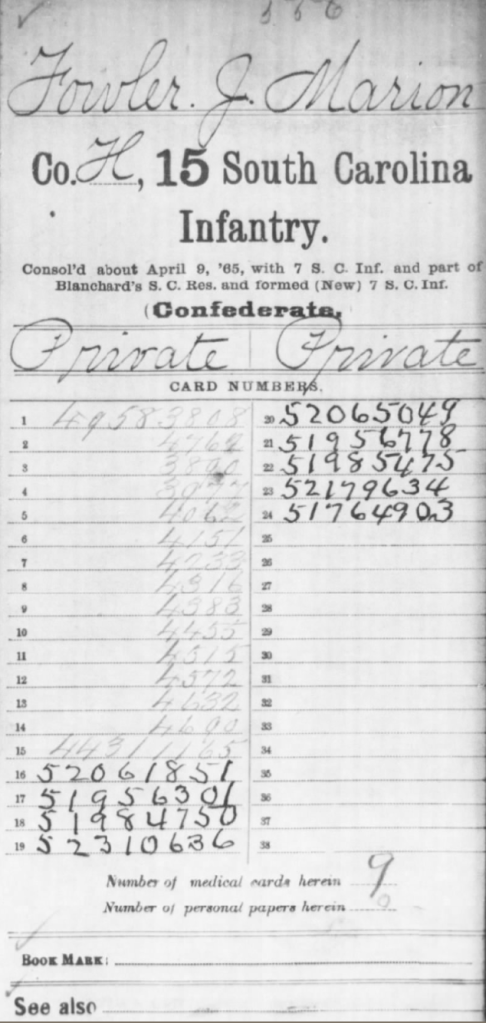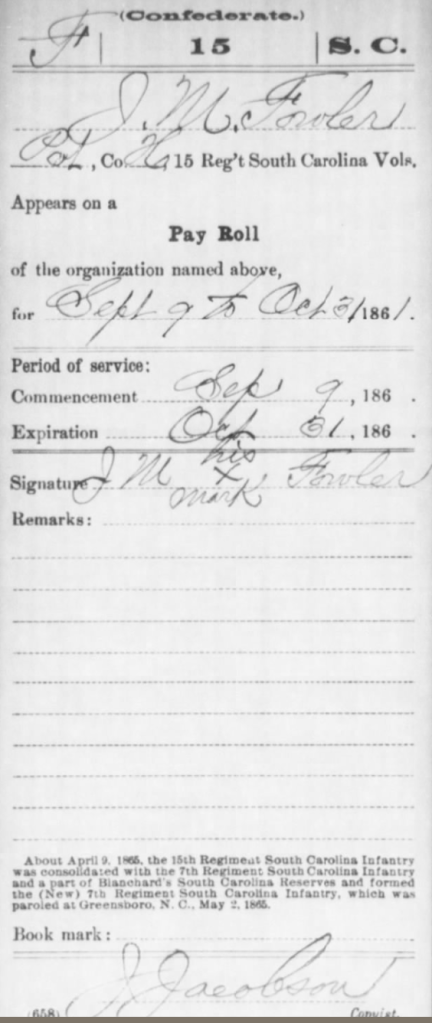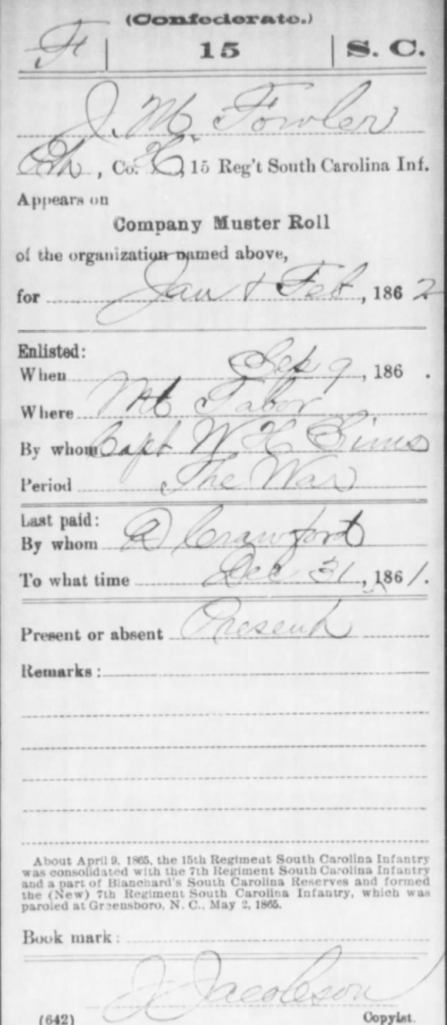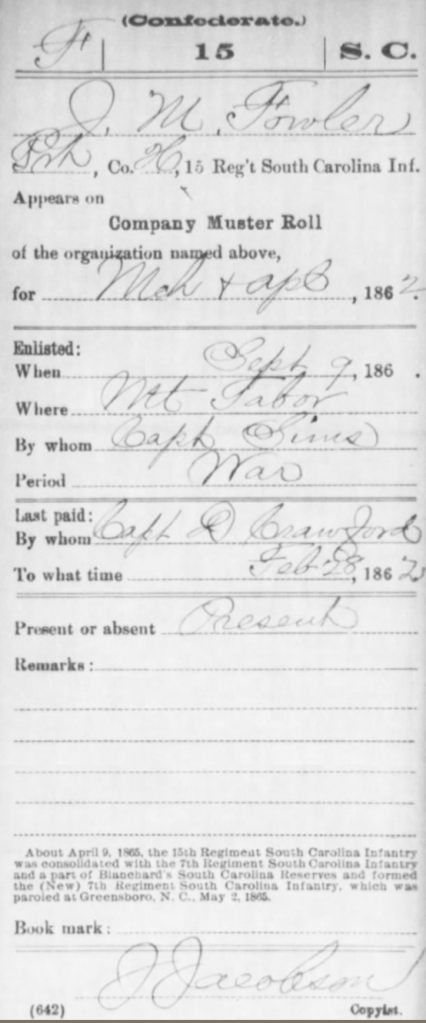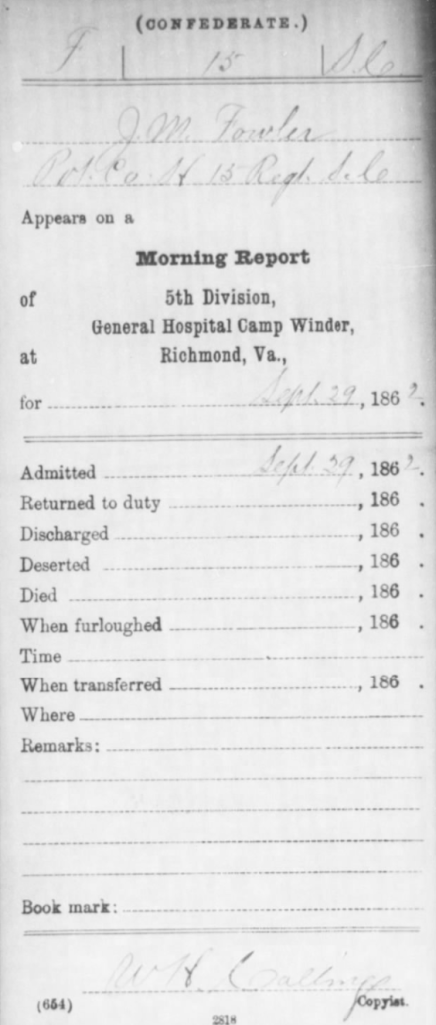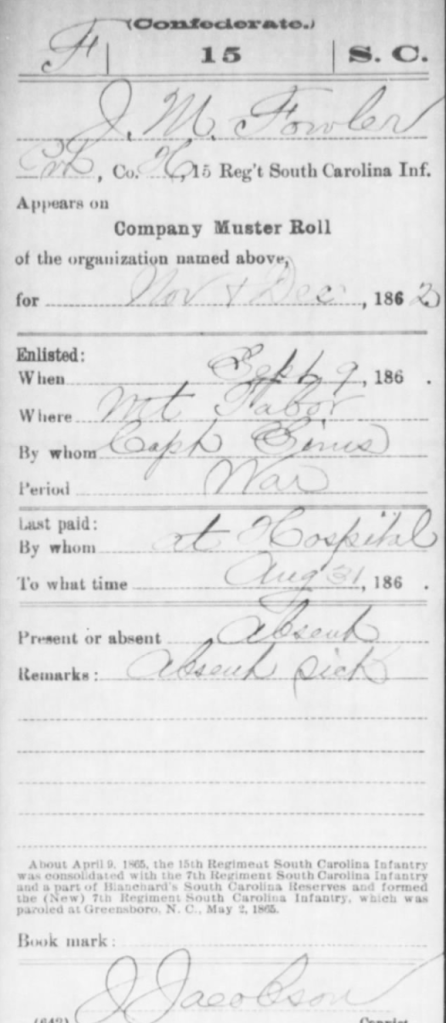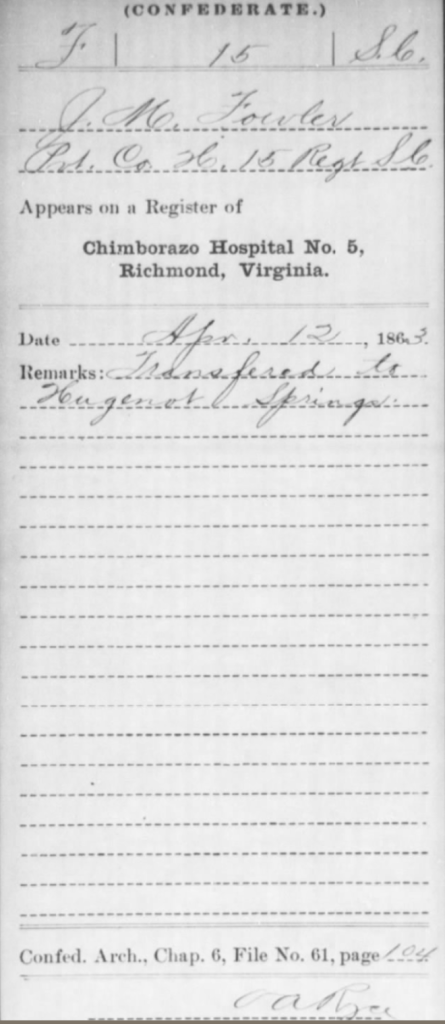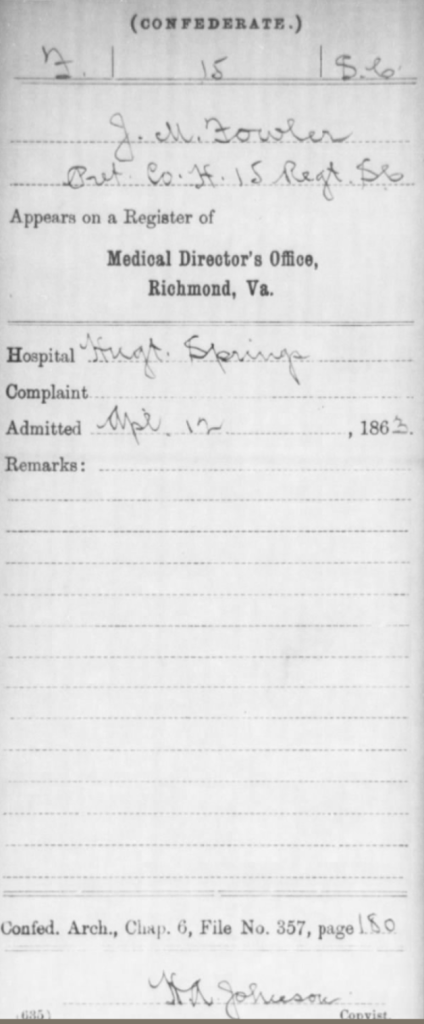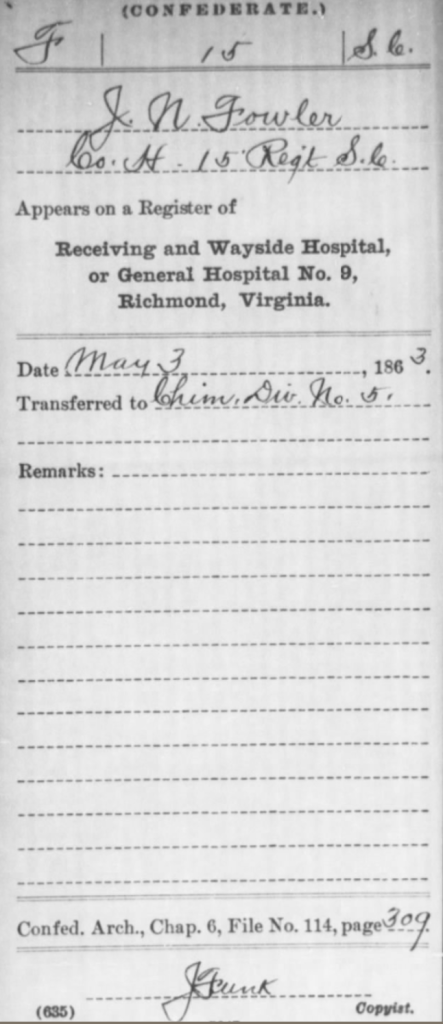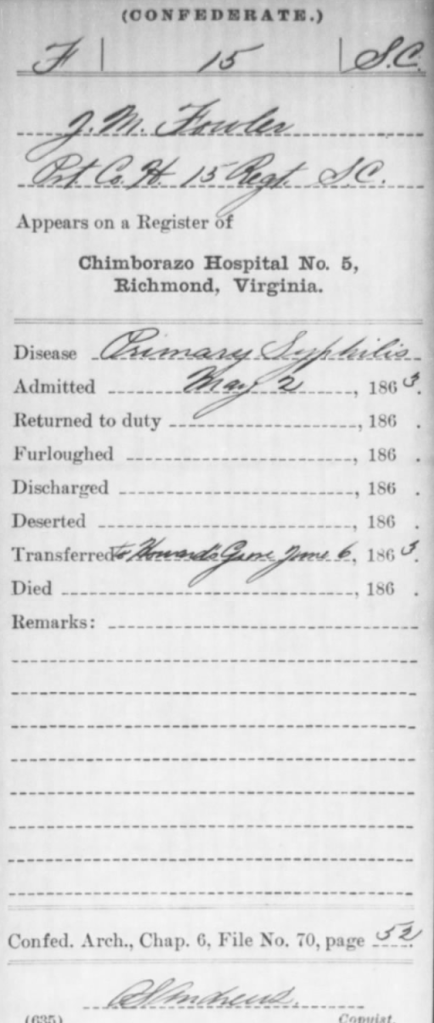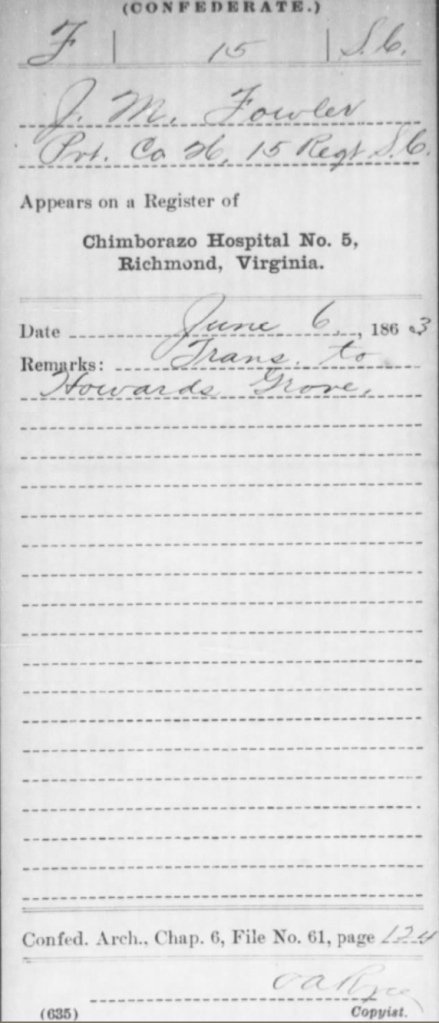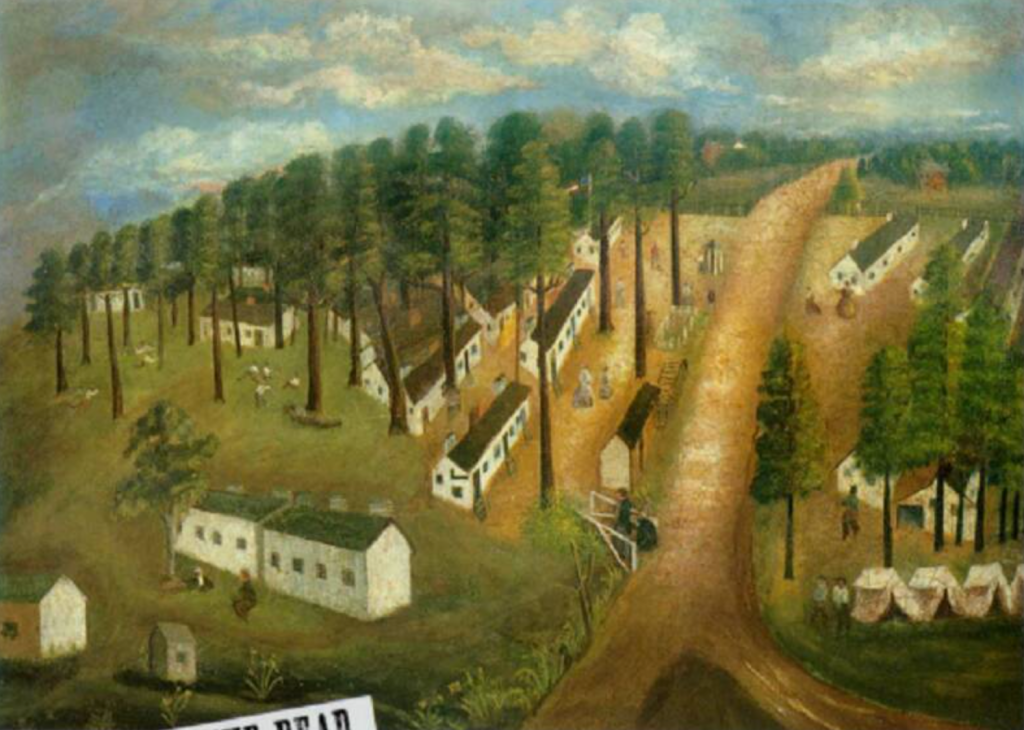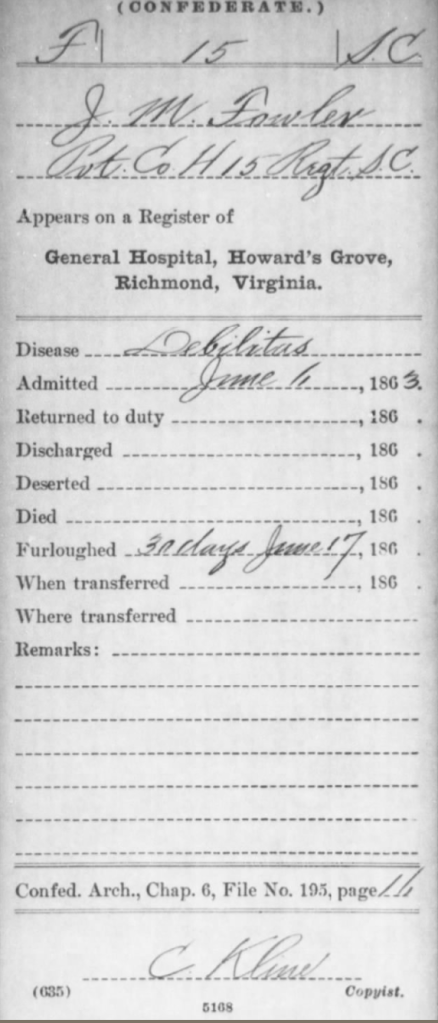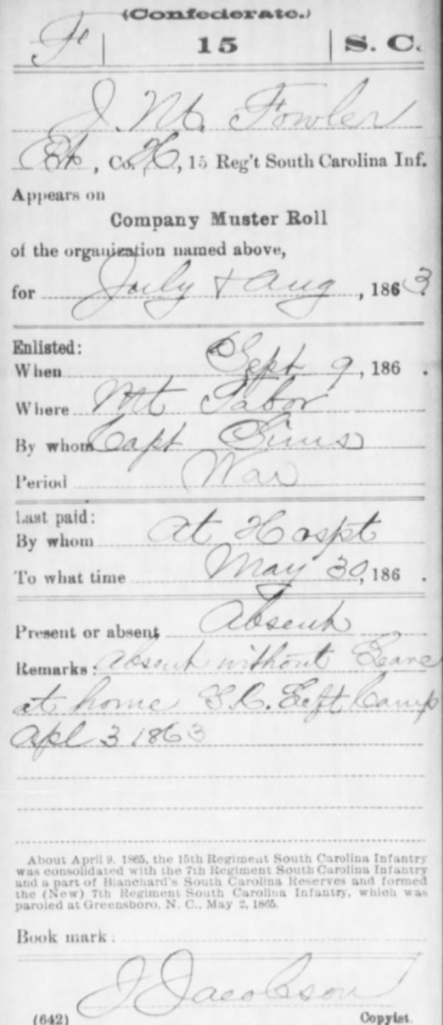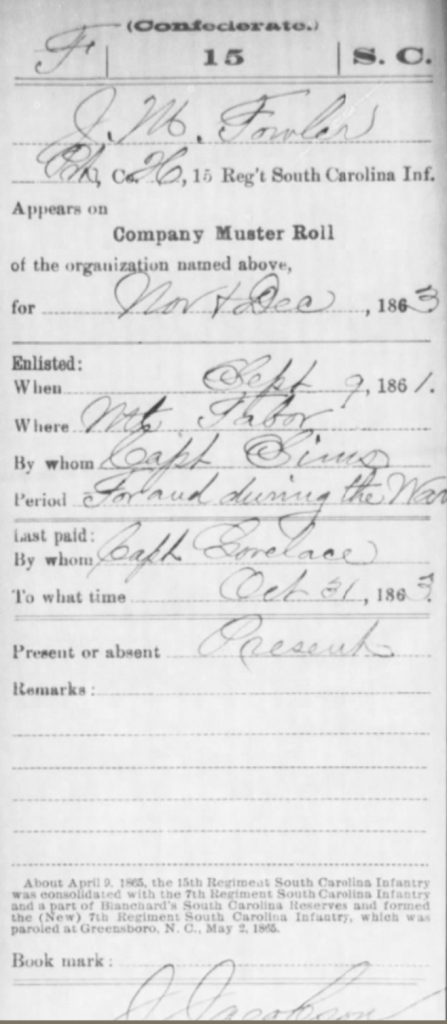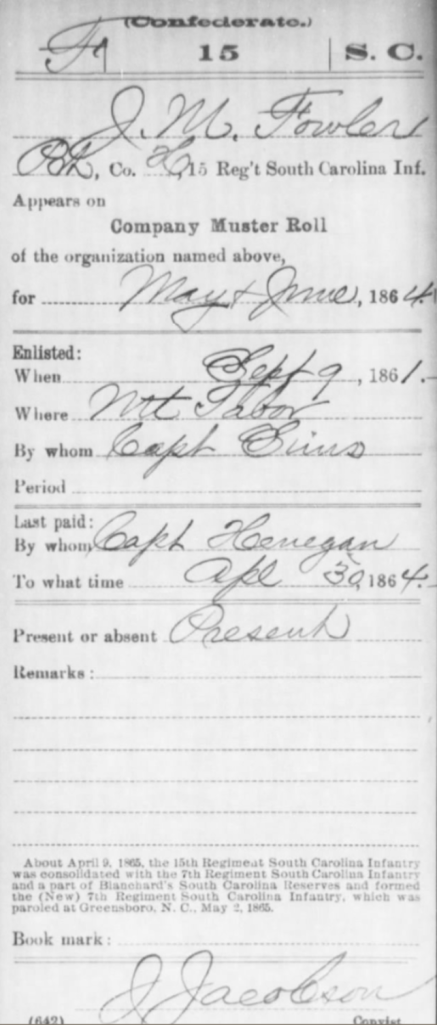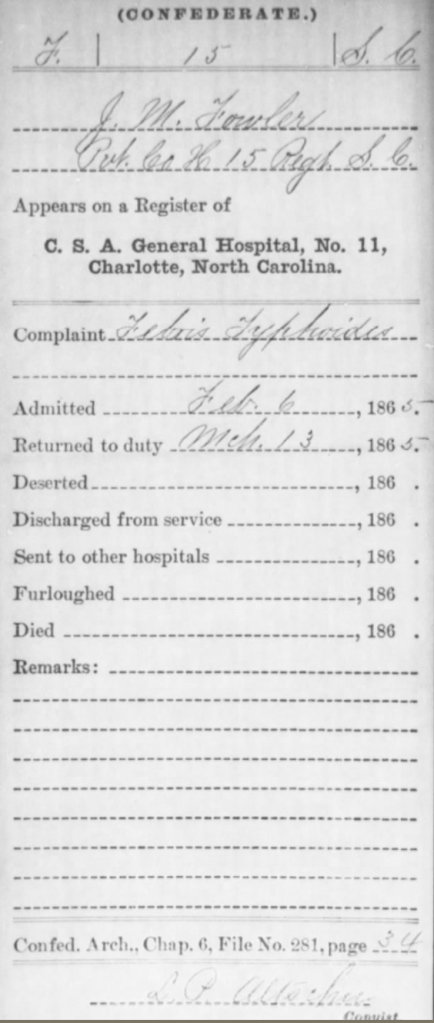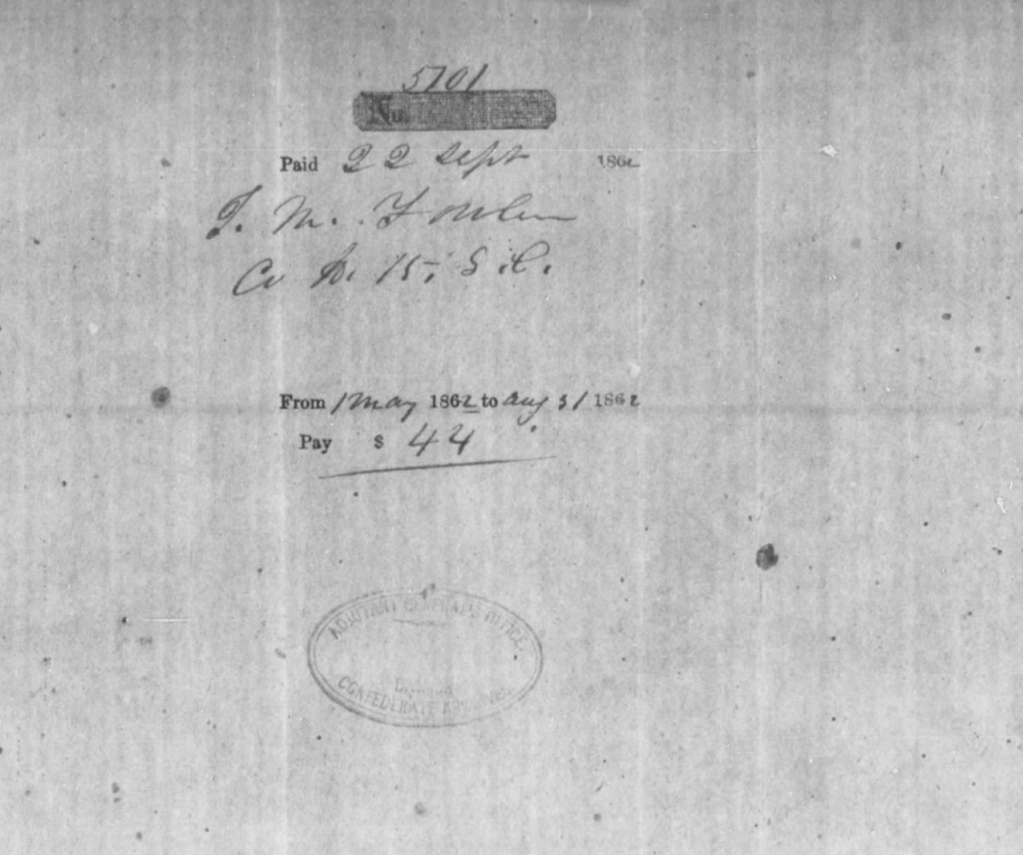J.M. Fowler enlisted in Captain W. H. Sims’ Company H, 15th Regiment South Carolina Volunteers on September 11, 1861 at Mount Tabor in Union County. He was mustered into military service on September 16, 1861 at Lightwood Knot Springs near Columbia.
Marion Fowler, son of Stephen Fowler, enlisted on the same day and place as J.M. Fowler: September 11, 1861 at Mount Tabor.
It is my belief that J. M. Fowler was also a son of Stephen Fowler. It is my belief that J.M. Fowler was James Morman Fowler, born in 1829 and who died after 1870.
With one exception , all entries for the military records for this man are under the name of J.M. Fowler. The exception is the Header Card which reads J. Marion Fowler.
My speculation of this consists of the knowledge that two Fowler men enlisted on the same day: Marion Fowler and J. M. Fowler.
I attribute “J. Marion Fowler” as a mix-up of the names Marion and Morman. Am I right? I do not know. I do know that there was no other man born in the appropriate time frame in Union County with the name J.M Fowler or J. Marion Fowler other than (James) Morman Fowler.
The Company Muster Rolls for September 1861-April 1862 reveal to us that J.M. Fowler was “present” in his regiment with no illness, capture, or furloughs.
The Company Muster Rolls for May-October 1862 are not in his folder, although there are records stating that he was admitted in Winder Hospital at Richmond, Virginia on September 29, 1862, and afterwards granted Furlough on October 9, 1862 for twenty days.
Named for General John Henry Winder (1800-1865), the Camp Winder Hospital in Richmond was easily the largest Confederate hospital with 98 buildings and eventually a 5000 patient capacity.
The hospital, like the man it was named after, had an unpleasant reputation. Filthy living conditions, starvation, and ill treatment of both Confederate hospital patients and Union Army prisoners alike made General Winder a controversial figure in his roles as provost marshal of Richmond and the general of Confederate prisons.
The Company Muster Roll for November/December 1862 reported “absent, sick” for J.M. Fowler. He had recovered by the first of the new year as he was “present” for the January/February 1863 Roll Call.
The March/April 1863 Muster Roll Call is missing. However, there are documents within his file that reveal his movements during this time.
J.M Fowler had been admitted into Wayside Hospital/General Hospital #9 at Richmond, Virginia prior to March 14, 1863, for that was the day he was transferred to Chimborazo Hospital #5 in Richmond.
Used previously as a tobacco warehouse, Wayside Hospital #9 (also known as Seabrook Hospital) was a transit hospital. Confederate soldiers were examined and given basic care for their immediate medical needs in these “wayside” hospitals, and then sent to hospitals better equipped to care for the sick or wounded men.
Chimborazo Hospital in Richmond was built specifically to treat the Confederate Army injured and sick. Between the beginning of the war in 1861 until the end in 1865, over 78,ooo soldiers came through its doors. Only six to eight thousand did not make it out alive, thus this hospital had one of the lowest mortality rates of of Civil War hospitals.

A most serious illness kept J.M. Fowler off the battlefield. He was shuffled from hospital to hospital as a result of his diagnosis: secondary syphilis.
It is a fact that more soldiers died from disease than on Civil War battlefields. Illness was unavoidable: these men lived in close quarters in filthy conditions. There was scant medical knowledge of how diseases spread. There were no antibiotics at the time. Many so called “cures” were often worse than the disease.
Since I research the Fowler family, I must mention that Thomas Fowler (1736-1801) of Stafford, England was convinced that a solution containing 1% potassium arsenite a suitable treatment for several diseases, including sylphilis. Fowler’s Solution was frequently used until the early 1900s when it finally fell out of favor.
One of the more common treatments for syphilis was even more toxic: Mercury. Mercurous chloride likely hastened the deaths of many who suffered from syphilis. It surely made the afflicted wish for death as the effects were excruciating and the methods of administration often barbaric. I do not know who coined the phrase ‘One night with Venus, a lifetime with Mercury’ but it was a fitting expression.
The soldiers of both armies –North and South — died by the thousands of typhoid fever, smallpox, measles, tuberculosis, diarrhea, malaria, and infected battle wounds.
In order to avoid the dreaded smallpox, soldiers engaged in a dangerous practice: they would introduce pus into their own body from an infected soldier suffering from the pox. It was simply a matter of scraping a lesion from an infected man, making a cut on their own body, and wiping the infected material into the cut. This gave them immunization from smallpox.
Or not.
Smallpox and syphilis had similar looking lesions. It was not uncommon for a soldier to introduce syphilis into his body instead of smallpox. Sadly, many cases of syphilis were transmitted between soldiers in this way during the war.
J.M. Fowler stayed at Chimborazo Hospital for a month, and then he was sent to the Hospital at Huguenot Springs, Virginia.
Planned by the Woolridge brothers, the Huguenot Springs Hotel Resort and Spa in Powhatan County, Virginia opened in 1847 and offered the local well-to-do a place of rest and relaxation.
The property was converted to a Confederate hospital in 1862, and the men lucky enough to be sent there were fed nourishing food by the local women who also nursed them back to health. Not only were their physical needs met, ministers were on hand to give spiritual comfort to the soldiers.
There are 250 men buried in unmarked graves who did not survive their wounds or illness. They, at least, had comfort at the end of life, unlike the thousands who died in battle or at other hospitals with inferior conditions and poor care.
The convalescent hospital at Huguenot Springs may have been the only place where J.M. Fowler received true comfort and care during his illness. It is unfortunate that his stay there was brief.
On May 5, 1863, he was sent back to the Chimborazo Hospital #5 with a downgraded diagnosis of primary syphilis.
A month later — on June 6, 1863 — J.M. Fowler was moved to Howard’s Grove Hospital in Richmond and placed into the section of the hospital where smallpox patients were treated.
Howard’s Grove had been an area of recreation before the war, but like so many places all over the south, the Confederate army took possession and turned it into a place of military operations. Its use as a hospital began June 1862; its sixty-two buildings eventually housed 1800 sick and injured men.
.J.M. Fowler was granted furlough for thirty days on June 17, 1863. He was “absent, sick at home, left camp 30 April” for the May/June 1863 Roll Call, and “absent without leave, at home” for the July/August 1863 report. The reason for his furlough was given as dēbilitās, i.e. weakness or infirmity.
It is obvious to this writer that Private Fowler became ill during April 1863, entered into the hospital and was transferred back and forth until he was given permission to go home. He overstayed his furlough, but returned back to his regiment sometime in September 1863. He was “present” for the Muster Rolls from September 1863 until June 1864.
There is another gap in his military records. There are no Muster Roll Calls after July 1864 but there are other documents that prove he was in his company until the end of the war.
J.M. Fowler was admitted into the CSA General Hospital in Charlotte, North Carolina on February 6, 1865 with a return to duty on March 13, 1865.
His diagnosis was typhoid fever. Considering the severity of symptoms of the disease, the lack of effective treatment, and his quick recovery time, I have to wonder if J.M. Fowler suffered from some other illness. Typhoid Fever was usually a death sentence.
There is little information on the Confederate hospitals in Charlotte. It is known that there were at least two hospitals operating at the close of the war: the transit Wayside Hospital No. 6, the main General Hospital No. 11.
In addition to the Muster Roll Calls and hospital records: two receipts for pay received are found in the military file of J.M.Fowler:
No doubt, the document that would have been the most important to J.M. Fowler is the one below, the undated Muster Roll of Officers and Men paroled at Greensboro, North Carolina on May 2, 1865.
The Civil War was finally over. The years of bloodshed on the battlefields had come to an end, but the heartache and hardships of the soldiers who returned home would continue for many, many years.
It must be assumed that J.M. Fowler made his way home and resumed his life back in Union County, South Carolina. Did he die from his illness or did he live a long life and die an old man in his bed?
If this man, J.M. Fowler, was one and the same as Morman Fowler, his death occurred after 1870, the last time his name appeared in a census record.
After 1870, I find no records for either J.M. Fowler or Morman Fowler. Of course, my search for proof of his life and his eventual death will continue. I know, deep in my heart, that I will find a document buried deep in the court house, and all will be revealed.
For more information on Morman Fowler, please click on this link:
